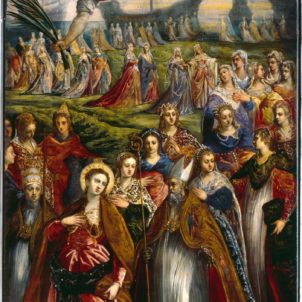Venice is celebrating one of her most famous sons, the great painter Jacopo Tintoretto, born 500 years ago, with a series of outstanding exhibitions: at the Doges’ Palace, at the Academia Galleries, at Scuola Grande San Rocco and at Scuola Grande San Marco-September 6th 2018 until January 6th, 2019.
Scuola Grande San Marco used to be the seat of a powerful benevolent lay organization, that during the centuries accumulated a striking art collection. Today this magnificent early Renaissance building, a 10 minutes’ walk from St Mark’s Square, is the seat of Venice’s major hospital, and you shouldn’t miss it!
The elegant façade, one of our preferred in Venice, was recently restored by Save Venice, an American organization active in Venice since 1971. Save Venice is also restoring a bulk of canvases by Jacopo and Domenico Tintoretto, father and son, including some works belonging to Scuola Grande San Marco itself.
ART, FAITH & MEDICINE IN TINTORETTO’S VENICE focuses on the functions of the Scuola Grande (active from the 14th century until Napoleon’s suppression), whose members, rich and poor, played an active role in the social, religious, medical and artistic life of Venice. It also exploits the unique collection of medical texts (8,000 books)possessed by the Hospital itself.

Jacopo and Domenico Tintoretto worked for the sodality, sponsored by some of its wealthiest and most outstanding members. Three masterpieces by Jacopo Tintoretto, illustrating the miracles of St Mark, were ordered and paid by Tommaso Rangone, doctor and astrologist, at the head of the Scuola since 1562.

The story St Mark’s ring, a precious relic acquired by the fraternity in 1509 and lost – it was stolen! – in 1575, epitomizes the popular belief in the healing power of relics, and witnesses the persistence of superstition and religious faith in a city were medical and scientific knowledge was developing fast.
We must remember that Padua University was absorbed by Venice in 1405.The Paduan Studium, founded in 1222, became, under the Venetian institutions, the most important medical school of the 16th century. The anatomical works of Acquapendente, Vesalio, Fallopio, changed the history of medicine forever.
Venice itself had no university until the 2nd half of the 19th century, gave however an enormous contribution to the medical and scientific world thanks to its intense printing activity, that had an early start thanks to the many German printers in town, and to the vitality of its cosmopolitan business activities.
Painters, engravers, editors contributed to the illustration of the medical texts. The importance of acquiring the greatest accuracy in the representation of the human body, with all its layers of anatomical details, implies a common effort in the artists’ and artisans’ workshops to obtain the best possible results.
Besides the human anatomy, drawers and engravers were asked to represent in detail the surgical instruments, the first protesis, and all what might interest medical and surgical practice.
Another reason why Venice was so involved in the medical studies was the struggle against plague epidemics. If on one hand the city rulers were very pragmatic, inventing quarantine and lazaret, on the other the cult of saints and the invocation of divine help was also considered fundamental,
Both Jacopo and Domenico Tintoretto were involved in the ‘spiritual’ fight against the terrible disease, that was typically considered a divine punishment. The exhibit displays an enormous processional canvas by Domenico Tintoretto, newly restored by Save Venice for the occasion, used during the 1630-1631 plague.

The display is articulated in seven sections: relating the history of the Scuola Grande San Marco and its spiritual/medical tasks; reconstructing the original display of the artworks before Napoleon’s suppression; framing the over-ambitious figure of Doctor Tommaso Rangone; dealing with the 1630/31 plague and Domenico Tintoretto’s processional painting; centering on the imporance of the anatomical studies in art and science of those days; presenting a video about the vicissitudes of St Mark’s miracle-working ring; show-casing some surprising surgical novelties of the time.

Catalogue
Title: Art, faith and medicine in TINTORETTO's Venice
Author: Matino, G. ; C. Klesinec
Price: $37.50
ISBN: 9788831729475
Description: Venezia: Marsilio, 2018. 28cm., pbk., 144pp. illus. Exhibition held at Palazzo Ducale, Venezia
Summary: The exhibition explores the representation of the human body in artistic and medical traditions and defines their role in renaissance culture. The Scuola Grande di San Marco offers the perfect scenario for the presentation of the relationship between art and medicine, anatomical studies and religious beliefs, drawing archive documents, illuminated manuscripts, rare books, prints, medals, drawings and paintings. The catalogue examines topics such as medical care for the poor brothers of the School as a means of spiritual purification and the figure of Tommaso Rangone as doctor and patron of Tintoretto.
Contents: Investment in Charity - The Welfare Activities of the Scuola Grande di San Marco in the Sixteenth Century, Paola Benussi ; Tommaso Giannotti Rangone, A Life Modeled on Books and (not just medical) Art, Sabrina Minuzzi ; 'When God's Majesty Publicly Scourges a People' - Combating Plague in Sixteenth-Century Venice, Michelle Laughran ; Domenico Tintoretto and the 1630-31 Plague, Jennifer Gear ; Animating the Body - The Roles and Reasons for Anatomical Study in the Renaissance, Cynthia Klestinec ; Domenico Tintoretto's Life-Drawing - Anatomy of an Artistic Reform, Gabriele Matino ; Learned Hands - Skills, Experience, and Knowledge in Sixteenth-Century Surgery, Paola Savoia ; Bookish Anatomies, The Medical Manual in the First Century of Printing, Ilaria Andreoli.

